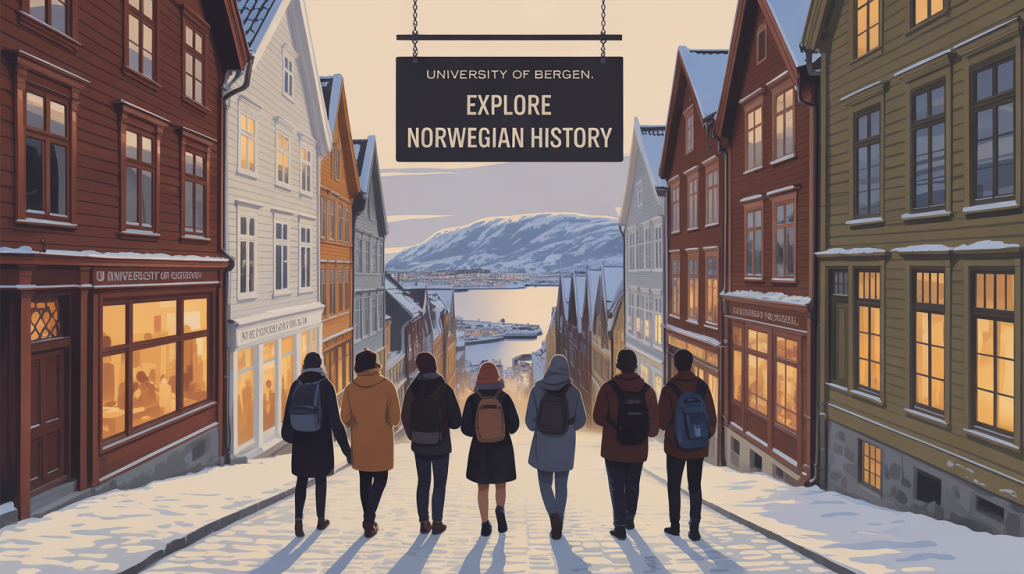Exploring Norwegian History Through University Courses: A Guide for International Students
- Norwegian History Through University Courses
- Bachelor’s and Master’s Programmes in History
- Key Courses Focusing on Norwegian History and Culture
- What Makes These Courses Unique?
- How International Students Can Get Started
- Why Study Norwegian History with Study in Norway?
- Final Thoughts
- Take the Next Step with Study in Norway
Norwegian History Through University Courses: Opportunities for International Students
Norwegian universities offer various tailored programmes for international students eager to delve into the nation’s historical evolution. From undergraduate to graduate levels, these courses present critical periods, such as the Viking Age, the development of Norwegian democracy, and social and economic changes following World War II.
Bachelor’s and Master’s Programmes in History
Bachelor’s Programme at NTNU
The Norwegian University of Science and Technology (NTNU) provides a comprehensive Bachelor’s degree in History that covers a broad range of historical events and themes.
Learn more about this programme here.
English-Taught Master’s Programmes across Norway
Several Norwegian universities offer master’s degree programmes in history that emphasize specialized topics related to Norwegian and European history. You can find details about these programmes on MastersPortal.
Key Courses Focusing on Norwegian History and Culture
| Course Title | University | Focus Areas | Language | Credit & Requirements |
|---|---|---|---|---|
| Introduction to Norwegian History (HFEL0010) | NTNU | Norwegian history from 1000–2000, emphasis on 1814–present; democracy, state development, societal changes | English (and Norwegian) | No previous knowledge required; reading list provided at semester start. |
| Norwegian Culture and History (SAS13) | University of Bergen (UiB) | Norwegian culture and history from Viking era to modern society | English | Requires at least one passed university exam; 7-day take-home examination as assessment. |
What Makes These Courses Unique?
- Comprehensive Historical Coverage: The curriculum spans nearly a millennium, charting the transformation from early medieval times through critical junctures like Norway’s 1814 constitution and post-WWII social democracy.
- Development of Academic and Critical Skills: Students learn to critically evaluate primary and secondary historical sources, reflect on societal changes, and situate Norway within European and global history.
- Diverse Teaching Methods: Learning modalities include lectures, seminars, independent research projects, and written assessments.
- Accessibility for International Students: Many courses have minimal prerequisites, making it easier for international students to enroll and succeed.
How International Students Can Get Started
- Identify Your Interest Area: Decide whether you prefer a broad undergraduate programme or specific courses focusing on Norwegian history and culture at the graduate level.
- Check Admission Requirements: Most history courses aimed at international students are taught in English; however, some may require proof of English proficiency or prior university qualifications.
- Application and Enrollment: Follow university application procedures, which often include submitting transcripts, proof of English proficiency, and personal statements.
- Prepare for Immersive Learning: Expect active participation in lectures, reading from extensive course materials, and independent critical analysis.
Why Study Norwegian History with Study in Norway?
- Comprehensive Recruitment Support: We work closely with international student recruiters, university admissions teams, and agencies.
- Expertise in International Admissions: Our dedicated team supports applicants through every step, from application submission to visa processes.
Final Thoughts: Enrich Your Educational Journey with Norwegian History
Exploring Norwegian history through dedicated university courses offers international students more than just academic credits—it provides a window into the cultural identity and societal development of Norway.
Take the Next Step with Study in Norway
Explore further how we can assist you in navigating your educational journey in Norway. Discover tailored courses and enriching opportunities.

